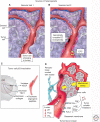Endothelial cell heterogeneity
- PMID: 22315715
- PMCID: PMC3253027
- DOI: 10.1101/cshperspect.a006429
Endothelial cell heterogeneity
Abstract
The endothelial lining of blood vessels shows remarkable heterogeneity in structure and function, in time and space, and in health and disease. An understanding of the molecular basis for phenotypic heterogeneity may provide important insights into vascular bed-specific therapies. First, we review the scope of endothelial heterogeneity and discuss its proximate and evolutionary mechanisms. Second, we apply these principles, together with their therapeutic implications, to a representative vascular bed in disease, namely, tumor endothelium.
Figures


References
-
- Aird WC 2001. Vascular bed-specific hemostasis: Role of endothelium in sepsis pathogenesis. Crit Care Med 29: S28–S35 - PubMed
-
- Aird WC 2006. Mechanisms of endothelial cell heterogeneity in health and disease. Circ Res 98: 159–162 - PubMed
-
- Aird WC 2007a. Phenotypic heterogeneity of the endothelium: I. Structure, function, and mechanisms. Circ Res 100: 158–173 - PubMed
-
- Aird WC 2007b. Phenotypic heterogeneity of the endothelium: II. Representative vascular beds. Circ Res 100: 174–190 - PubMed
-
- Aird WC 2009. Molecular heterogeneity of tumor endothelium. Cell Tissue Res 335: 271–281 - PubMed
Publication types
MeSH terms
Substances
LinkOut - more resources
Full Text Sources
Other Literature Sources
Medical
